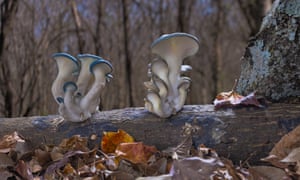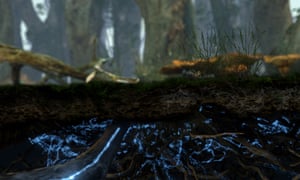Spore’s the pity: how Fantastic Fungi flags up man’s abuse of nature | Film
Watching the anemone stinkhorn sprout from the soil is a wondrous – and terrifying – thing. Emerging from a pod that looks like a truffle, the mushroom unfurls half a dozen arms, all a throbbing scarlet, like a collection of tongues. Each of these is forked and, across their stems, a series of black sticky lumps pop up like rotting barbecue. It’s supposed to smell something awful too.
The uncanny blooming of the Aseroe rubra is one of many transfixing moments in Fantastic Fungi, a crowdfunded US documentary made by Louie Schwartzberg, an affable old hippie and pioneer of time-lapse photography. It stars Paul Stamets, a trailblazer in the popularisation of mycology, the study of fungi, and bursts with footage revealing the secret life of mushrooms. It also seeks to usher the viewer into a seductive world where fungi are the answer to some of mankind’s biggest questions.
Schwartzberg has shot time-lapse footage for blockbusters (The Bourne Ultimatum) avant garde movies (Koyaanisqatsi), and for Pope Francis (projected on to the Vatican walls in support of the Paris climate agreement). Time-lapse has been his specialism for four decades.He began soon after graduation, unable to afford regular 35mm. “It was $100 per minute for film and processing. If you shoot time-lapse, you only shoot one frame every 10 minutes, and that means you’re not burning much film. I shoot about two seconds of screen time every 24 hours. From 40 years, I’ve got 20 hours.

‘I love the idea of my camera as a time machine’ … Fantastic Fungi
“Plants are moving, but we can’t see it. But that doesn’t mean they’re not alive. I love the idea of using my camera as a time machine to be able to look at the world from the point of view of other living things. That’s how you become more open-minded.” Contemplation of the world of fungi, he believes, can in turn offer insights into how human society might learn from the natural world.
The key to this understanding is the role of mycelia. The stuff that forms the fuzz on your iffy apple, mycelia are networks of fungal filaments. With the ability to extend to kilometres in length, they play a complex and powerful role in natural ecosystems. Among other things, they are ardent recyclers, working through dead natural material (and unnatural, species of fungi have been shown capable of breaking down plastics and crude oil) to create nutrients that are ploughed back into the soil or the roots of plants.
“I’m just in love with what they represent,” Schwartzberg says. “This economy under the ground where nutrients are shared without greed for ecosystems to flourish. This idea of a network that shares … is sort of the model that we need to live our lives on. To change our social structure to. It’s just a beautiful metaphor, without being preachy.”
The film sometimes nudges into evangelism, however. Brie Larson’s voiceover frequently assumes the role of fungi’s spiritual spokesperson, uttering lines such as: “When you sense the oneness you are with us.” Fantastic Fungi’s mission is to persuade the viewer of the beauty of organisms that leave many queasy, to live in harmony with the natural world – and to regularly ingest psychedelic drugs.
Schwartzberg is an advocate of the consumption of magic (psilocybin) mushrooms. Stamets says a substantial dose in his youth cured his lifelong stutter, as well as opening his mind to the glories of the natural world – mostly after teaching himself mycology. He now has 40 patents, and his company, Fungi Perfect, which generates $30m in revenue a year, helps to fund further research.
Stamets believes in the potential for psilocybin to be used effectively as a medicine, in helping treat both depression and dementia. This is the focus of the work at a new “centre for psychedelic research” at Johns Hopkins University.
“What gives me hope is that this is a revolution from the ground that is sweeping the planet,” Stamets says. “Louie’s movie is extremely timely … so is the realisation that psilocybin mushrooms make you happier and make you smarter. Who doesn’t want to be happier and smarter? Actually, some people don’t.”
As affable as Schwartzberg is via Zoom, Stamets is stern. He is worn out by his interactions with the media, frustrated even more by humanity’s inability to appreciate our inextricable place in the natural world, and our need to help preserve it. He decries “the hubris of human beings thinking they’re so smart, [that they can] make a calculation on the value of the ecosystems that got us here today”.

Mushroom socialism … mycelia in action in Fantastic Fungi
Stamets also believes in the curiosity and acuity of young people to help force change in a more sustainable direction. The next generation of mycologists are given their moment in the final act of Fantastic Fungi, and it’s inspiring. But Stamets’ outlook is gloomy. Our disregard for the natural world, he says, has left us exposed to the ravages of viruses (something mycelia often help to stave off in nature). This has led us to Covid-19, but the current pandemic might only be the beginning.
“We have now entered into a whole new stage in the evolution of our society,” Stamets says. “We have now gone from viral storms, which are rare and few, to viral hurricanes. We will have viral hurricanes coming to us seasonally as a new norm. There’s not going to be one at a time, it’s going to be overlapping and repetitive. This is really all hands on deck.
“The only solution for us to survive this is by protecting natural ecosystems and living in harmony with nature. Not extracting and exploiting it to the ultimate harm of the commons. If we reinvest in the commons, we have a lot of microbial allies in nature that will leap up to disperse. But we are destroying the guilds of micro-organisms that grew up to support us.”
A stark prognosis. Happily, however, it seems the tools for our salvation are still within our reach, just below our feet.
• Fantastic Fungi is released on 9 November on digital formats.

